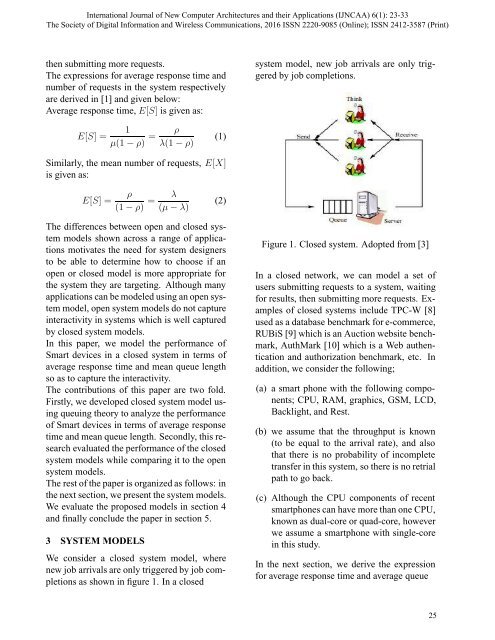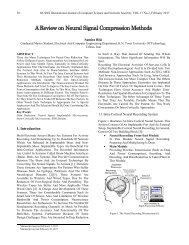New Computer Architectures and their Applications
IJNCAA_Vol6No1
IJNCAA_Vol6No1
Create successful ePaper yourself
Turn your PDF publications into a flip-book with our unique Google optimized e-Paper software.
International Journal of <strong>New</strong> <strong>Computer</strong> <strong>Architectures</strong> <strong>and</strong> <strong>their</strong> <strong>Applications</strong> (IJNCAA) 6(1): 23-33<br />
The Society of Digital Information <strong>and</strong> Wireless Communications, 2016 ISSN 2220-9085 (Online); ISSN 2412-3587 (Print)<br />
then submitting more requests.<br />
The expressions for average response time <strong>and</strong><br />
number of requests in the system respectively<br />
are derived in [1] <strong>and</strong> given below:<br />
Average response time, E[S] is given as:<br />
system model, new job arrivals are only triggered<br />
by job completions.<br />
E[S] =<br />
1<br />
µ(1 − ρ) = ρ<br />
λ(1 − ρ)<br />
(1)<br />
Similarly, the mean number of requests, E[X]<br />
is given as:<br />
E[S] =<br />
ρ<br />
(1 − ρ) = λ<br />
(µ − λ)<br />
(2)<br />
The differences between open <strong>and</strong> closed system<br />
models shown across a range of applications<br />
motivates the need for system designers<br />
to be able to determine how to choose if an<br />
open or closed model is more appropriate for<br />
the system they are targeting. Although many<br />
applications can be modeled using an open system<br />
model, open system models do not capture<br />
interactivity in systems which is well captured<br />
by closed system models.<br />
In this paper, we model the performance of<br />
Smart devices in a closed system in terms of<br />
average response time <strong>and</strong> mean queue length<br />
so as to capture the interactivity.<br />
The contributions of this paper are two fold.<br />
Firstly, we developed closed system model using<br />
queuing theory to analyze the performance<br />
of Smart devices in terms of average response<br />
time <strong>and</strong> mean queue length. Secondly, this research<br />
evaluated the performance of the closed<br />
system models while comparing it to the open<br />
system models.<br />
The rest of the paper is organized as follows: in<br />
the next section, we present the system models.<br />
We evaluate the proposed models in section 4<br />
<strong>and</strong> finally conclude the paper in section 5.<br />
3 SYSTEM MODELS<br />
We consider a closed system model, where<br />
new job arrivals are only triggered by job completions<br />
as shown in figure 1. In a closed<br />
Figure 1. Closed system. Adopted from [3]<br />
In a closed network, we can model a set of<br />
users submitting requests to a system, waiting<br />
for results, then submitting more requests. Examples<br />
of closed systems include TPC-W [8]<br />
used as a database benchmark for e-commerce,<br />
RUBiS [9] which is an Auction website benchmark,<br />
AuthMark [10] which is a Web authentication<br />
<strong>and</strong> authorization benchmark, etc. In<br />
addition, we consider the following;<br />
(a) a smart phone with the following components;<br />
CPU, RAM, graphics, GSM, LCD,<br />
Backlight, <strong>and</strong> Rest.<br />
(b) we assume that the throughput is known<br />
(to be equal to the arrival rate), <strong>and</strong> also<br />
that there is no probability of incomplete<br />
transfer in this system, so there is no retrial<br />
path to go back.<br />
(c) Although the CPU components of recent<br />
smartphones can have more than one CPU,<br />
known as dual-core or quad-core, however<br />
we assume a smartphone with single-core<br />
in this study.<br />
In the next section, we derive the expression<br />
for average response time <strong>and</strong> average queue<br />
25






